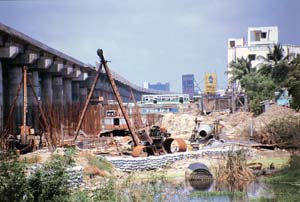|
The confusion surrounding the eventual fate of the river Cooum has increased in the last few weeks with the decision of the Ministry of Environment and Forests to grant clearance to the proposal for construction of an elevated expressway from the Port to Maduravoyal.
|

Does this fate of the Buckingham Canal await the Cooum River?
|
It is noteworthy to point out that this project had been earlier rejected twice by the same Ministry on grounds of environmental concern. With this, a question also arises over the proposed Cooum River cleaning project, in collaboration with an agency in Singapore, which was recently announced.
The elevated corridor, which is expected to ease congestion and help in the movement of vehicles to the port, was announced a couple of years ago and the foundation stone for the Rs. 1600 crore project was laid by the Prime Minister in January this year. Originally planned as a corridor running over the Poonamallee High Road, its alignment has undergone a couple of changes since. Those in charge had voiced the view that land acquisition in Poonamallee High Road would be an issue and the road was thereafter planned to run along the Cooum. This was resisted by the Tamil Nadu State Coastal Zone Management Authority (TNSCZMA) which claimed that the proposal to build the road along the Cooum violated Coastal Regulation Zone (CRZ) clearance norms.
Surprisingly enough, the TNSCZMA has now reversed its stance and stated that the proposed road will not affect the free flow of water in the riverbed. This despite the fact that around 34.58 hectare of the road will fall within the CRZ and, more importantly, 35 foundation pits will fall within the riverbed. To all intents and purposes this means the road will effectively be built on the riverbed and this will obstruct the flow of water.
To those who have seen what happened to the Buckingham Canal, all this is not new. The MRTS was built on the canal bed and this permanently destroyed that water body, at least within the city. Since then, all announcements to the effect that the canal would be revived as a navigable waterway have remained hollow promises. The sinking of pillars into the canal has also ensured that the waterway is not effective as a storm-water drain and now causes flooding in neighbouring areas. The same practice, if adopted with the Cooum, can spell a bigger disaster as the river flows over several crowded localities.
The latest development also makes those interested in the welfare of the Cooum wonder as to what would happen to the Rs. 1200 crore river cleaning scheme. In order to ensure its success, a Central River Authority was formed and a high-profile tie-up with the Singapore Co-operation Enterprise was announced. Families who were living along the river bank were evicted. A master plan for the river, it was announced, would soon be made available for public consultation. As to how this will be impacted by the elevated road is anybody’s guess.
|